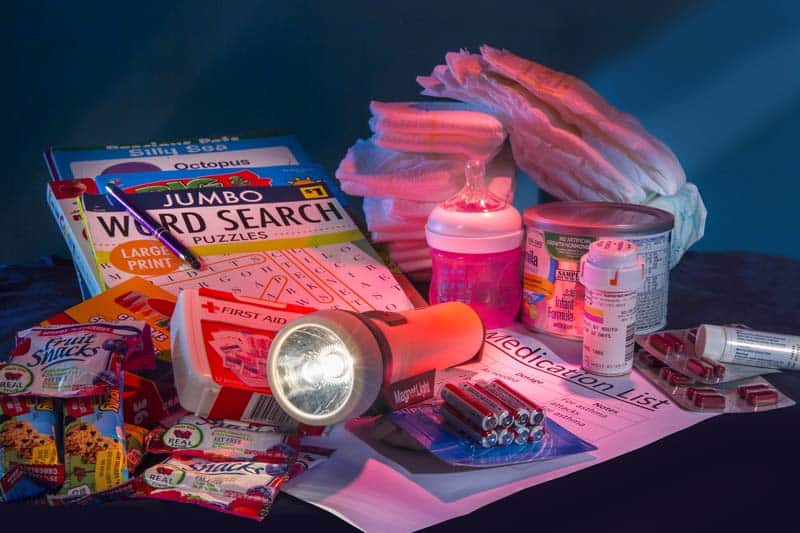How to create a hurricane kit and find out if you live in an evacuation zone
All eyes are on Milton as we wait to find out which path this storm will take– which means now is the time to prepare just in case.
While many Tampa Bay families are making preparations now, having an emergency kit AND first-aid kit ready to go year-round is a must for any family.
Our friends at Johns Hopkins All Children's Hospital are sharing some easy ways you can build these two important, potentially life-saving kits.
We're also sharing ways you can connect with your local emergency management office to stay up-to-date on what's happening in your neighborhood. Tampa Bay is a huge place, after all.
How to prepare for a storm and pack your hurricane kit
Start by learning your evacuation zone and get familiar with the evacuation routes you will need to take if your family must leave, and discuss where you will go. Visit FloridDisaster.org's KNOW YOUR ZONE page here to find out whether you live in an evacuation zone.
If you live in an evacuation zone, make arrangements before the storm to stay with friends or family who live further inland or on higher ground now so you are ready when evacuation orders come down.
Families with children who have special needs should register with their local health department and emergency operations offices to find out the location of their special needs shelter in case of evacuation.
Also, not all shelters for the public will accept pets, so you’ll want to check in advance on which ones will accommodate your four-legged family members.
Please note, Johns Hopkins All Children’s is open for emergency care, but is not a shelter.
Get familiar with your local emergency management office:
Hillsborough County: HillsboroughCounty.org
Sign up for HCFL Alert emergency alerts: Text StaySafe to 888-777
Pasco County: Pascocountyfl.net
Be sure to sign up for Alert Pasco while visiting the site.
Pinellas County: PinellasCounty.org/emergency
You can sign up for Alert Pinellas on this site too to stay connected during emergencies.
Where to connect with your county's Facebook page for local storm preparedness and response updates:
- Hillsborough County Emergency Updates
- Pinellas County Emergency Updates
- Pasco County Emergency Updates
- Polk County Emergency Updates
- Manatee County Emergency Updates
- Hernando County Emergency Updates
- Citrus County Emergency Updates
Here's what your family's emergency kit should include:
- List of important contacts and phone numbers
- Water (enough for at least 72 hours, but a 7-day supply is ideal). The rule of thumb is one gallon of water per person per day.
- Necessities for young children include formula, wipes, and diapers
- Non-perishable food items, including anything needed for special dietary concerns
- Flashlights and extra batteries, including extra external phone batteries
- A weather radio
- Activities to keep kids busy (Electronics will run out of power within a few hours, so gather other distractors such as coloring books, board or card games or other favorite activities that don’t depend on batteries.)
- Prescription medications (and related medical equipment such as nebulizer/mask or spacer and mask for those with asthma)
- Bedding for a small space
- Infant or child necessities (wipes, diapers, bottles)
- A safe place for your baby to sleep, like a pack-and-play crib.
- Personal hygiene items
- Change of clothes
- Eyeglasses
- Important papers and valid ID; consider bringing copies of your child’s vaccination and/or medical record
- Cash
Here's what to include in a first-aid supply kit:
When it comes to a first aid kit, think about the basics for small injuries like cuts and scrapes, but also family specific items.
For example, if your child has allergies that require an epi-pen or daily antihistamine pill, or if they have asthma, don’t forget their nebulizer and/or inhaler with spacer and mask. Here is a list to get your family started:
- Bandages (in different sizes)
- Antibiotic ointment
- Gauze pads and wraps
- Compression bandage for sprains/strains
- Ice Pack (particularly for home)
- Pain relievers/anti-inflammatory medication
- Antihistamine (liquid, pill and/or topical cream for rashes, bites and stings)
- Plastic bag or small container to hold items in your first aid kit
For more tips and a printable check list, you can also visit: FloridaDisaster.org/Kit
If a hurricane watch or warning is issued in your area –what are your next steps?
- Again, know your evacuation zone if you don’t already. Visit FloridaDisaster.org's KNOW YOUR ZONE page here to find out whether you live in an evacuation zone. If an evacuation is ordered for your neighborhood, be ready to go as quickly as possible.
- Double check–make sure your disaster kit is fully stocked and bring it with you if you are evacuating.
- Make sure your baby has as safe place to sleep like a pack and play crib.
- If you live in an area outside evacuation zones, reach out to friends and family who may need your help if a storm strikes.
When it comes to evacuating, the general rule of thumb is tens of miles, not hundreds of miles. You RUN FROM WATER and HIDE FROM WIND.
*Presented by Johns Hopkins All Children’s Hospital | A portion of this article was originally published in the July 2022 issue of Tampa Bay Parenting Magazine, but the information was updated in October 2024
Related stories we think you'll LOVE:
- ABC Action News Meteorologist Denis Phillips talks hurricane prep, what to expect for the 2022 season and Rule #7
- ASK THE DOCTOR: How to help your teen cope with stress and anxiety


